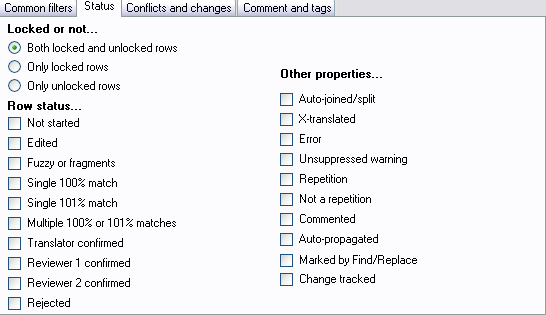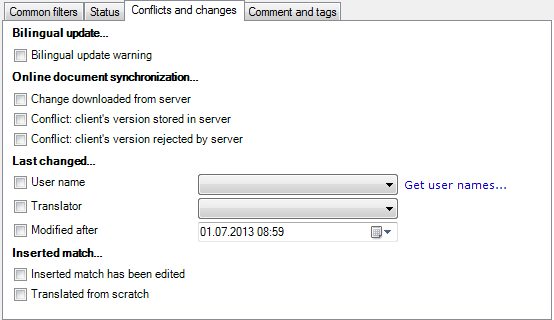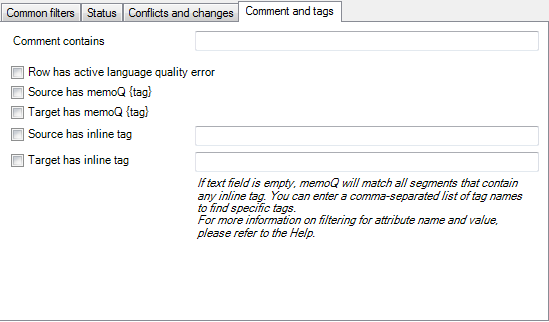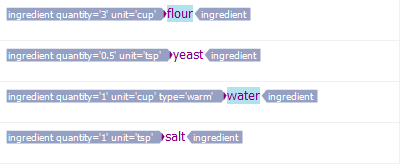|
The translation grid allows you to edit the contents of a translation document manually. Translation documents, however, often contain a multitude of segments, and may be hard to navigate. The Create view (filtering and sorting) dialog allows you to create a view with filtered or sorted segments of the selected translation documents, so that you can work with it easily. After creation, these views can be opened from the Views tab in the Translations pane of Project home. Note: A view is more or less a 'virtual document', a unit composed together from various segments in the different documents of your project. For more on views, see the Views topic in the Managing projects, documents and resources section of memoQ Help. How to beginThis is the full version of the Create view dialog. To display it, first open a local project. In the Documents tab of the Translations pane of Project home, select one or more documents, and then click the Create view command on the Documents ribbon tab. memoQ displays the simple Create view dialog. At the bottom of this dialog, click Advanced options. UseThe four filtering options sections enable you to define a subset of all segments in the view to see. By using the filters, you will not see segments irrelevant to you. Note: If you specify more than one filtering options, the view will include only those segments, which match all of these filtering options. In formal logic, this is called an 'AND' relationship. Options in the Sort segments in view section allow you to set the order in which the segments are displayed. This will help you in navigation. •Name of the view: Use this field to enter the name of the view you want to create from the selected translation documents. Filtering optionsFilter by frequency section In this section, you can set up a filter so that the view shows only those segments that appear in the selected translation documents at least so many times that you specified, and it also enables you to see the repetitions only once. •Minimum frequency: Select this check box to see only those segments that appear in the selected translation documents at least so many times that you specified in the spin control box right to the check box. •Keep duplicates: Select this check box to see only once those segments that appear in the selected translation documents more times. Note: If you check both check boxes, the view will include only those segments that appear in the selected translation documents at least so many times that you specified, and all of these segments will appear in the view only once. Filter by text section Specify words or series of words to look for. If you filter for segments, you will only see those segments that contain the words you specified – either in the source language or in the target language. •Source content: This list view shows all the words or series of words you are looking for on the source side. •Case sensitive (upper): Select this check box to distinguish between upper case and lower case characters when looking for matches, i.e. memoQ will not be found if you enter Memoq. Disable it to get more results. •Add (upper): Click this button to add a word or series of words you are looking for on the source side, after entering it to the text field right to the Source content list. Note: If you add an entry to the Source content list containing multiple words divided by white space, the view will include only those segments in which all of these words appear on the source side. In formal logic, this is called an 'AND' relationship. If you add more entries to the Source content list, the view will include all those segments in which any of these entries appear on the source side. In formal logic, this is called an 'OR' relationship. •Remove (upper): Click this button to remove the selected word or series of words from the Source content list. •Target content: This list shows all the words or series of words you are looking for on the target side. •Case sensitive (lower): Select this check box to distinguish between upper case and lower case characters when looking for matches, i.e. memoQ will not be found if you enter Memoq. Disable it to get more results. •Add (lower): Click this button to add a word or series of words you are looking for on the target side, after entering it to the text field right to the Target content list. Note: If you add an entry to the Target content list containing multiple words divided by white space, the view will include only those segments in which all of these words appear on the target side. In formal logic, this is called an 'AND' relationship. If you add more entries to the Target content list, the view will include all those segments in which any of these entries appear on the target side. In formal logic, this is called an 'OR' relationship. •Remove (lower): Click this button to remove the selected word or series of words from the Target content list. Segment range section Extract part of a document. You can specify the row numbers for the starting segment and the ending segment of the selected translation document. This option can be helpful when a large file should be split up into smaller pieces to be assigned to more than one translator. •Only segments from row [number] to row [number]: Select this check box to look for only those segments of the selected translation document that you specified in the spin control boxes. Note: This option is only available if you have selected only one translation document when invoking this dialog. Filter by segment status section This section has four tabs that allow you to filter segments by their status, the comments and tags they contain, and their updated or synchronized state (in local copies of online projects). Common filters: a simple choice of segment status filters
Status: the full choice of segment status filters
Updates and synchro: See if the document was modified by another user
Comments and tags: filter segments by the text in comments and inline tags
Note: If you select more check boxes among the filtering options (maybe even across different tabs), the view will include segments that match all specified settings. In formal logic, this is called an 'AND' relationship. If you specify criteria that are not met by any of the segments of the selected translation documents, the view will be empty. Sorting OptionsIn the Sort segments in view section, you can specify the criteria for sorting contents of the selected translation documents. •No sorting: Select this radio button to not sort contents of the translation document. •Alphabetical by source: Select this radio button to sort contents of the translation document by the source language entries, alphabetically. •Alphabetical by target: Select this drop-down list element to sort contents of the translation document by the target language entries, alphabetically. •Source text length: Select this drop-down list element to sort contents of the translation document by the source language entries, by length. •Target text length: Select this drop-down list element to sort contents of the translation document by the target language entries, by length. •Match rate: Select this drop-down list element to sort contents of the translation document by the match rate of the source language entries, in increasing order. •Frequency: Select this drop-down list element to sort contents of the translation document by the frequency of the source language entries, in increasing order. •Sort order: Use this drop-down list to show contents in increasing or decreasing order: oAscending: Select this drop-down list element to show contents in increasing order (i.e. A–Z; shortest–longest; less–more). oDescending: Select this drop-down list element to show contents in decreasing order (i.e. Z–A; longest–shortest; more–less). •Last changed: Select this radio button to sort by the view by last changed (the user who last changed the rows). •Segment status: Select this radio button to sort the view by segment status. NavigationAfter specifying the filtering and sorting options, click the OK button to create the view with these settings, or click Cancel to close the dialog without creating a view. |




